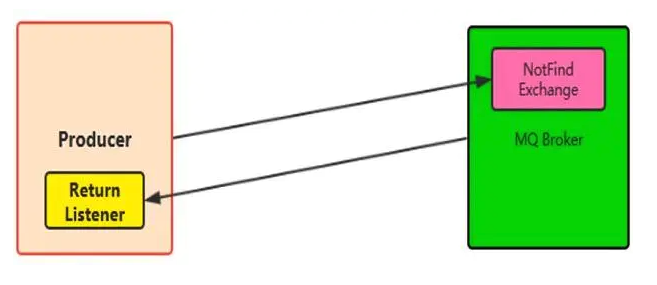RabbitMQ的Return消息机制
大约 2 分钟
RabbitMQ的Return消息机制
1. Return机制简介
Return Listener用于处理一些不可路由的消息!- 我们的消息生产者,通过指定一个Exchange 和Routingkey,把消息送达到某一个队列中去, 然后我们的消费者监听队列,进行消费处理操作!
- 但是在某些情况下,如果我们在发送消息的时候,当前的exchange不存在或者指定的路由key路由不到,这个时候如果我们需要监听这种不可达的消息,就要使用
Return Listener

2. Return机制实现
- 添加return监听:
addReturnListener,生产端去监听这些不可达的消息,做一些后续处理,比如说,记录下消息日志,或者及时去跟踪记录,有可能重新设置一下就好了 - 发送消息时,设置
Mandatory:如果为true,则监听器会接收到路由不可达的消息,然后进行后续处理,如果为false,那么broker端自动删除该消息!
3. Return机制演示
3.1 生产端
public class ReturnProducer {
public static void main(String[] args) throws Exception {
//1 创建ConnectionFactory
ConnectionFactory connectionFactory = new ConnectionFactory();
connectionFactory.setHost("192.168.43.157");
connectionFactory.setPort(5672);
connectionFactory.setVirtualHost("/");
//2 获取Connection
Connection connection = connectionFactory.newConnection();
//3 通过Connection创建一个新的Channel
Channel channel = connection.createChannel();
String exchange = "test_return_exchange";
//String routingKey = "return.save";
String routingKeyError = "abc.save";
String msg = "Hello RabbitMQ Return Message";
//添加return监听
channel.addReturnListener(new ReturnListener() {
@Override
public void handleReturn(int replyCode, String replyText, String exchange,
String routingKey, AMQP.BasicProperties properties, byte[] body) throws IOException {
//replyCode:响应码 replyText:响应信息
System.err.println("---------handle return----------");
System.err.println("replyCode: " + replyCode);
System.err.println("replyText: " + replyText);
System.err.println("exchange: " + exchange);
System.err.println("routingKey: " + routingKey);
//System.err.println("properties: " + properties);
System.err.println("body: " + new String(body));
}
});
//5 发送一条消息,第三个参数mandatory:必须设置为true
channel.basicPublish(exchange, routingKeyError, true, null, msg.getBytes());
}
}
3.2 消费端
public class ReturnConsumer {
public static void main(String[] args) throws Exception {
//1 创建ConnectionFactory
ConnectionFactory connectionFactory = new ConnectionFactory();
connectionFactory.setHost("192.168.1.1");
connectionFactory.setPort(5672);
connectionFactory.setVirtualHost("/");
//2 获取Connection
Connection connection = connectionFactory.newConnection();
//3 通过Connection创建一个新的Channel
Channel channel = connection.createChannel();
String exchangeName = "test_return_exchange";
String routingKey = "return.#";
String queueName = "test_return_queue";
//4 声明交换机和队列,然后进行绑定设置路由Key
channel.exchangeDeclare(exchangeName, "topic", true, false, null);
channel.queueDeclare(queueName, true, false, false, null);
channel.queueBind(queueName, exchangeName, routingKey);
//5 创建消费者
QueueingConsumer queueingConsumer = new QueueingConsumer(channel);
channel.basicConsume(queueName, true, queueingConsumer);
while(true){
Delivery delivery = queueingConsumer.nextDelivery();
String msg = new String(delivery.getBody());
System.err.println("消费者: " + msg);
}
}
}
4. 运行说明
先启动消费端,访问管控台:http://192.168.1.1:15672,检查Exchange和Queue是否设置OK,然后启动生产端。 由于生产端设置的是一个错误的路由key,所以消费端没有任何打印,而生产端打印了如下内容
---------handle return----------
replyCode: 312
replyText: NO_ROUTE
exchange: test_return_exchange
routingKey: abc.save
body: Hello RabbitMQ Return Message
如果我们将 Mandatory 属性设置为false,对于不可达的消息会被Broker直接删除,那么生产端就不会进行任何打印了。如果我们的路由key设置为正确的,那么消费端能够正确消费,生产端也不会进行任何打印。
参考文章
Loading...